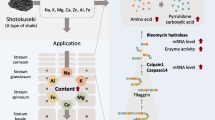Summary
Incubation of human plantar stratum corneum (SC) with trypsin at various pH suppressed the typical “keratin pattern” in the cytoplasm of the horny cells and disclosed tonofilaments and desmosomal attachment plates as they are seen in living keratinocytes. Tonofilaments were 62–75 Å wide and showed a 100–120 Å periodicity. This effect was non-specific since it was also obtained by incubation of SC with citric acid or sodium citrate, but it was not due to hydration alone. Partial acantholysis was obtained by incubation with trypsin followed by citric acid. After simultaneous action of trypsin in sodium citrate and in citric acid, cell membranes were separated from the cytoplasm and many of them were broken around desmosomes with subsequent isolation of desmosomes. The role of trypsin in this effect was uncertain. These findings strongly suggest that the filamentous network built up by living keratinocytes remains almost unchanged during the keratinization process although no longer visible under E.M.
Zusammenfassung
Die Inkubation der menschlichen plantaren Hornschicht mit Trypsin unter verschiedenen pH unterdrückt das typische Keratinmuster im Cytoplasma der Hornzellen, löst die Tonofilamente und desmosomalen Haftstellen, wie sie beim lebenden Keratinocyten beobachtet werden. (Die Tonofilamente waren 62–75 Å weit und zeigten eine Periodizität von 100–120 Å.) Dieser Effekt war nicht trypsinspezifisch, denn er wurde auch durch Inkubation des Stratum corneum mit Zitronensäure oder Natriumcitrat erhalten. Aber dieser Effekt konnte nicht auf die Hydratation alleine zurückgeführt werden. Eine partielle Akantolyse wurde durch Inkubation mit Trypsin nach Zitronensäurezusatz erhalten. Nach gleichzeitiger Anwendung von Trypsin und Natriumcitrat und Zitronensäure wurde die Zellmembran von Cytoplasma abgehoben und in der Folge dieses Vorgangs wurde eine Lösung und Isolation der Desmosomen beobachtet. Die Rolle des Trypsins auf diesen Effekt war ungewiß. Diese Ergebnisse lassen vermuten, daß das filamentöse Netzwerk, das durch lebende Keratinocyten aufgebaut wird, im Verlaufe der Keratinisation unverändert bestehen bleibt, obwohl es unter dem Elektronenmikroskop nicht länger erkennbar ist.
Similar content being viewed by others
References
Baden HP (1970) Enzymatic hydrolysis of the α-protein of epidermis. J Invest Dermatol 55:184–187
Brody J (1950) The ultrastructure of the tonofibrils in the keratinization process of normal human epidermis. J Ultrastruct Res 4:264–297
Brody J (1963) The ultrastructure of the epidermis in psoriasis vulgaris as revealed by electron microscopy. J Ultrastruct Res 8:566–579
Fukuyama K, Buxman MM, Epstein WL (1968) The preferential extraction of keratohyalin granules and interfilamentous substances of the horny layer. J Invest Dermatol 51:355–364
Fukuyama K, Black M, Epstein WL (1974) Ultrastructural studies of newborn Rat epidermis after trypsinization. J Ultrastruct Res 46:219–229
Kligman AM (1964) The epidermis. Montagna W, Lobitz WC, Jr (eds.) Academic Press, New York, p 387
Matoltsy GA (1962) Fundamentals of keratinization. Butcher EO, Sognmaes RF, (eds). Am Assoc for Advancement of Sci Washington, DC, pp 1–26
Middleton JC (1968) The mechanism of water binding in stratum corneum. Br J Dermatol 80:437
Nagy-Vezekenyi K, Nagy IZ, Torok E (1975) Die Wirkung einiger Lösungsmittel auf die Epidermis. Arch Dermatol Forsch 252:53–61
Reynolds ES (1963) The use of lead citrate at high pH as an electron-opaque skin in electron microscopy. J Cell Biol 17:208–212
Rothberg S, Axelrod GD (1967) Enzymatic solubilization of insoluble protein at neutral pH. Science 156:90
Skerrow CJ, Matoltsy G (1974) Isolation of epidermal desmosomes. J Cell Biol 63:515–521
Van Scott ES, Yu RJ (1974) Control of keratinization with α-Hydroxyacids and related compounds. Arch Dermatol 110:586–590
Weibel ER, Schnyder UW (1966) Zur Ultrastruktur und Histochemie der granulösen Degeneration bei bullöser Erythrodermie congenitale ichtyosiforme. Arch Klin Exp Dermatol 225:286–298
Author information
Authors and Affiliations
Additional information
Clinique de Dermatologie, Faculté de Médecine
Rights and permissions
About this article
Cite this article
Nicollier, M., Agache, P., Kienzler, J.L. et al. Action of trypsin on human plantar stratum corneum. Arch Dermatol Res 268, 53–64 (1980). https://doi.org/10.1007/BF00403886
Received:
Issue Date:
DOI: https://doi.org/10.1007/BF00403886




